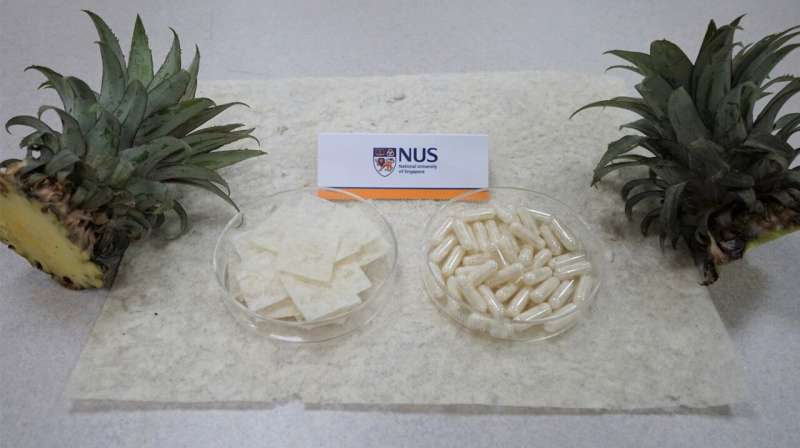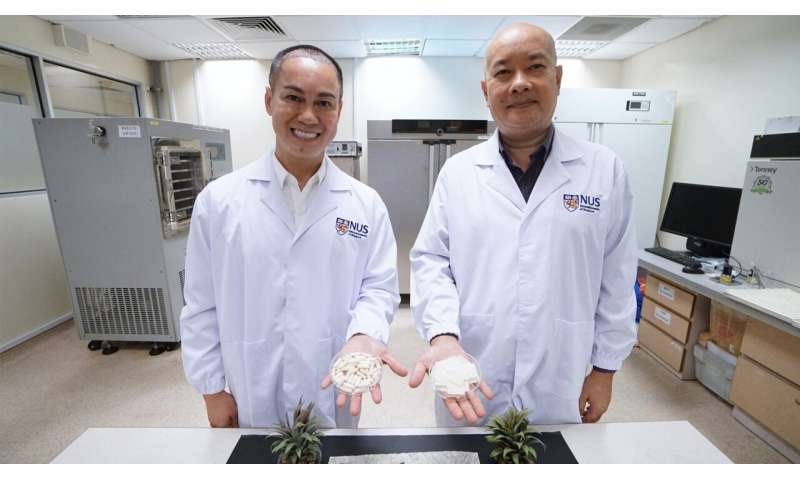
Imagine swallowing a capsule or munching a cracker made from pineapple leaf fibers to lose weight at a fraction of the cost of fat burners currently available in the market. A multidisciplinary team of researchers from the National University of Singapore (NUS) has come up with an innovative way to upcycle pineapple leaves for fat absorption, a world first.
“Pineapple leaves are natural, biodegradable and biocompatible. They are usually discarded after the fruits are harvested, hence they are very cheap and abundant. In our recent work, we capitalized on the excellent mechanical properties of pineapple leaf fibers for fat absorption, a high-value application. Together with our earlier work of using pineapple leaves for production of highly absorbent aerogels, our goal is to help reduce agricultural waste and increase profits of farmers,” explained research team leader Associate Professor Duong Hai-Minh, who is from the Department of Mechanical Engineering under the NUS College of Design and Engineering.
This novel approach for waste reduction proposed by the NUS team could be used for other types of cellulose fibers, such as sugarcane bagasse and coffee grounds.
Natural, low-cost fat trappers
Fat plays important roles in human body such as storing energy, supporting cell growth, controlling blood pressure, and allowing fat-soluble vitamin absorbed. However, a high consumption of fatty foods can result in a high cholesterol level, which is related to serious diseases such as high blood pressure, heart attack and cancer.

It is estimated that 35.5% and 39.1% of Singapore residents aged 18 to 74 years old have high blood pressure and high cholesterol respectively. A healthy, low-fat diet as well as appropriate weight loss for obese individuals could help to lower the risk of such cardiovascular diseases.
The global market size of weight loss supplements was valued at US$33.4 billion in 2020 and it is projected to expand at a compound annual growth rate of 16.6% from 2021 to 2028. Chitosan, chromium picolinate, conjugated linoleum acid (CLA), and green tea extract are common ingredients in dietary weight-loss supplements. However, there is a lack of scientific evidence to support the effectiveness of such fat-trapping supplements. Most fat trappers or fat burners are also expensive—some regimens could cost several hundred dollars a month.
Assoc Prof. Duong explained, “Fat trappers—in the form of capsules or crackers—made using pineapple leaf fibers are significantly cheaper as the raw material is inexpensive and the production method developed by our team is very cost effective. Other cellulose-based fibers or powder can also be used for this purpose.”
“After ingestion, the capsule or cracker absorbs fatty compounds (such as animal fats) and form fat-coated fiber lumps. These fat-coated lumps will then be passed out from the digestive system in one to three days, similar to other foods we consume,” said research team member Associate Professor Phan Toan Thang, who is from the Department of Surgery under the NUS Yong Loo Lin School of Medicine.
In laboratory tests that simulate the acidic condition of the human digestive tract, the NUS team found that one gram of pineapple leaf fibers can absorb 45.1 grams of cooked fats and 20.4 grams of human fats. “Based on our test results, you will need less than one capsule of pineapple leaf fibers to absorb the saturated fats from eating one hamburger,” Assoc Prof. Duong added.
Source: Read Full Article